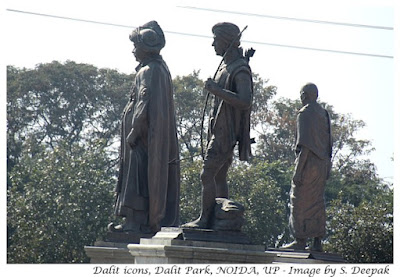India has many rich religious traditions during which the Gods are supposed to come down to the earth and express themselves through some persons. Examples of similar traditions can be found in different parts of India. (Click on the images for a bigger view)
Gods Speaking Through Humans
Hindus believe that the Divine is present in each living being as universal consciousness. At the same time, they have a pantheon of a huge number of Gods and Goddesses, one for each of life’s different forms. The Gods, animals and plants are all inter-linked through the sacred stories and myths.The religious ceremonies in which Gods speak through humans has 2 main functions – (i) as a part of celebration of specific religious and social events; and, (ii) to answer questions and to give blessings to people.
In many parts of India, there are also elaborate make-up, costumes and rituals linked with this tradition. For example, in North Dinajpur district of West Bengal, persons manifesting the Gods wear colourful wooden masks during the sowing of fields – this tradition is known as Gomira. In East Burdwan district of West Bengal, the men invoking the Gods, paint their bodies with blue colour and transform into Shiva – this tradition is known as Shiva Gajan. Satyajit Ray's film Devi can be seen as one representation and exploration of similar ideas.
While God-manifestation roles are mostly enacted only by men, usually they are about Goddesses, the different forms of Shakti. In some places, persons of other religions, especially Muslims & Christians, are given specific roles to play during these ceremonies image below with Muslim characters in a Theyyam), which could be linked with specific historical events and indicate processes of religious inclusion.
Theyyam Tradition in North Kerala
The word “Theyyam” probably comes from “Devam” (God). This religious tradition is common in villages of northern Kerala, especially around the district of Kannur and surrounding areas of Kerala and Karnataka. Between October to March, every village holds one annual Theyyam at the village temple. In each temple, there can be different Gods/Theyyams, depending upon the presiding deity and his consorts. Bhagwati is one of the principle deities of the Theyyam.The persons playing Theyyams usually belong to specific lower castes in villages. The responsibility belongs to specific families and is hereditary, so that male children watch and learn from their fathers and uncles putting on the make-up, making specific ritualistic dance movements and conducting specific rituals in the temple. For the duration of the Theyyam, persons of all castes, bow in front of Theyyams.
Visiting Theyyam ceremonies
I had seen a few Theyyam dancers in a cultural festival in Guwahati some years ago and had been struck by their elaborate make-up and costumes. Then, a few years ago, in a museum near Fort Kochi, I had seen the masks showing specific make-up face-patterns for different Theyyams, which had greatly intrigued me.It is easier to see Theyyam performances as part of cultural shows, but I was interested in seeing them as a part of a living religious tradition of a village.
In February 2018, during a visit in Kerala, I had gone to Kunnur, where I had hired a local Theyyam guide. You can find online the calendar of Theyyam celebrations in different villages. However, more specific information is available only in Malayalam. Finding and reaching specific villages where the celebrations are being held is not very easy unless you know the local areas. Thus, a local guide can make things easier.
With my guide Chandran, I had visited Theyyam ceremonies in 2 different villages and seen different Theyyams, each with their special make-up and costume. As you can see from the pictures, both were colourful ceremonies filled with beautiful rituals, dances and faithful. Even elderly persons touched their feet and asked for their blessings.
Conclusions
In one of the villages I visited, I watched a young man patiently lying on the ground for a couple of hours, while the make-up of God Narsimha was being put on his face. While he was getting ready, his uncle, Mr. Narayan, who was one of the drummers and had come home from Delhi, especially for this ceremony, had explained to me the significance of different steps of his preparation.That transformation had touched me deeply. Gods and humans, together and separate, are bound together in the sacred stories of human imagination - Theyyam is an illustration of this bond.





















.jpg)

.jpg)
.jpg)
.jpg)

.jpg)
.jpg)
.jpg)
.jpg)

.jpg)
.jpg)
.jpg)
.jpg)
.jpg)
.jpg)
.jpg)




